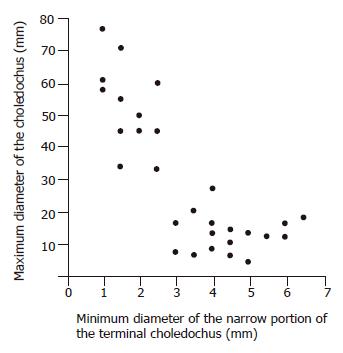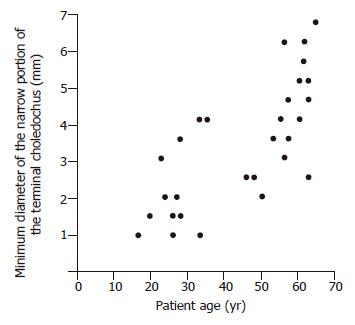Copyright
©2005 Baishideng Publishing Group Inc.
World J Gastroenterol. Nov 7, 2005; 11(41): 6503-6507
Published online Nov 7, 2005. doi: 10.3748/wjg.v11.i41.6503
Published online Nov 7, 2005. doi: 10.3748/wjg.v11.i41.6503
Figure 1 Endoscopic retrograde cholangiopancreatogram in a 55-year-old woman with gallbladder cancer associated with AUPBD and cylindrical biliary dilatation (A).
Diagram of the cholangiopancreatogram (B). The minimum diameter of the narrow portion of the terminal choledochus is 4 mm, and the maximum diameter of the upstream choledochus is 15 mm. AUPBD: anomalous union of the pancreatic and biliary ducts; NDS: narrow distal segment; P-B ductal union: pancreaticobiliary ductal union; narrow portion: narrow portion of the terminal choledochus; MPD: main pancreatic duct.
Figure 2 Endoscopic retrograde cholangiopancreatogram in a 21-year-old woman with AUPBD and cystic biliary dilatation (A).
Diagram of the cholangiopancreatogram (B). The minimum diameter of the narrow portion of the terminal choledochus is 1.5 mm, and the maximum diameter of the upstream choledochus is 57 mm. Proximal dilatation of the MPD is also seen. AUPBD: anomalous union of the pancreatic and biliary ducts; NDS: narrow distal segment; P-B ductal union: pancreaticobiliary ductal union; narrow portion: narrow portion of the terminal choledochus; GB: gallbladder; MPD: main pancreatic duct.
Figure 3 There was a strong negative correlation between the minimum diameter of the narrow portion of the terminal choledochus and the maximum diameter of the upstream choledochus (r = -0.
78, P < 0.001).
Figure 4 Patient’s age was strongly correlated with the minimum diameter of the narrow portion of the terminal choledochus (r = 0.
78, P<0.001).
Figure 5 Patient’s age was negatively correlated with the maximum diameter of the choledochus (r = –0.
53, P = 0.001).
- Citation: Nomura T, Shirai Y, Wakai T, Yokoyama N, Sakata J, Hatakeyama K. Narrow portion of the terminal choledochus is a cause of upstream biliary dilatation in patients with anomalous union of the pancreatic and biliary ducts. World J Gastroenterol 2005; 11(41): 6503-6507
- URL: https://www.wjgnet.com/1007-9327/full/v11/i41/6503.htm
- DOI: https://dx.doi.org/10.3748/wjg.v11.i41.6503













